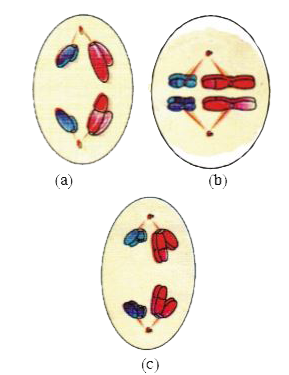I. It is the final phase of prophase I
II. Termination of chiasmata occurs
III. Fully condensed chromosomes
IV. Spindle is assembled
V. Nucleolus and NM breaks down
The above characteristic are attributed to -
Zygotene
Diakinesis
Diplotene
Metaphase I
The correct Answer is:B
To solve the question regarding the characteristics attributed to a specific phase of prophase I, we will analyze each statement step by step.
1. Identify the Phase: The question states that it is the final phase of prophase I. In meiosis, prophase I consists of several stages: Leptotene, Zygotene, Pachytene, Diplotene, and finally Diakinesis. Therefore, we can conclude that the phase in question is Diakinesis.
2. Termination of Chiasmata: During Diakinesis, the chiasmata (the points where homologous chromosomes exchange genetic material) begin to separate. This is a key feature of this phase, confirming that the statement is accurate.
3. Fully Condensed Chromosomes: In Diakinesis, chromosomes are fully condensed and visible under a microscope. This characteristic is also true for this phase.
4. Spindle Assembly: The assembly of the spindle apparatus occurs during Diakinesis as the cell prepares for metaphase. This characteristic is consistent with the features of Diakinesis.
5. Breakdown of Nucleolus and Nuclear Membrane: During Diakinesis, the nucleolus disappears, and the nuclear membrane breaks down, allowing the spindle fibers to attach to the chromosomes. This characteristic is also true for this phase.
Conclusion:
All the characteristics listed in the question are indeed attributed to Diakinesis, which is the final phase of prophase I in meiosis.
Final Answer:
The above characteristics are attributed to Diakinesis.
---
All the characteristics listed in the question are indeed attributed to Diakinesis, which is the final phase of prophase I in meiosis.
The above characteristics are attributed to Diakinesis.
Similar Questions
A single set of chromosomes is found in
I. Germinal cell
II. spermatogonium
III. primary spermatocyte
IV. Secondary Spermatocyte
V. SpermatidView SolutionI. Forms major component within organs
II. Cell wall - thin, cellulosic
III. Shape of cells - generally isodiametric
IV. Intercellular space - Present / absent
V. Photosynthetic, storage or secretory'in function
The above characters are attributed toView Solution
Knowledge Check
- Question 1 - Select One
Go through the following events-
I. Termanlzation of chiasmata occurs
II. Chromosomes are fully condensed
III. Meiotic spindle is assembled
IV. By the end NM and nucleolus disappear
The above points indicate that it is -AZygotene stageBDiakinesis stageCMetaphase IIDPachytene - Question 2 - Select One
Common changes that occur in prophase of mitosis and prophase-I of meiosis are
I. Formation of bivalents
II. Condensation of chromatin
III. Chromosomal movement to poles
IV. Disappearance of nuclear membrane and nuclear membrane and nucleolus
V. Splitting of centromereAI, IV, V onlyBII, IV onlyCIII, IV onlyDI, II, III only - Question 3 - Select One
Go through the following statements.
I. Meiosis is similar to mitosis
II. Terminalization of chiasmata occurs in meiosis -II.
III. Meiosis -II performs separation of homologous chromosomes.
IV: Interphase is intermitosis.
V. After mitosis, the number of chromosomes in daughter cells shall-one fourth of parent cell.
Pick up the correct statementsAI, III, VBI, II, IIICI, II, IVDI ,IV
There are certain properties related to adsorption
I. reversible
II. Formation of unimolecular layer
III. , low heat of adsorption
IV., occurs at low temperature and decreases with increasing temperature
Which of the above properties are for physical adsorption ?View SolutionChoose the correct statements with respect to the completion of prophase
I. Chromosomal material condenses to from compact mitotic chromosomes. Chromosomes are seen to be composed of two chromatids attached together at the centromere.
II. Initiation of the assembly of mitotic spindle, the microtubules, the proteinaceous components of the cell cytoplasm
III. Cells at the end of prophase, when viewed under the microscope, do not show golgi complexes, endoplasmic reticulum, nucleolus and the nuclear envelopeView SolutionArrange the following events of meiosis in correct sequence :
(a) Crossing over
(b) Synapsis
( c ) Terminalisation of chaismata
(d) Disappearance of nucleolusView Solution
Match the above figures (a, b, c) with their events given below :-
(I) Nucleolus disappear
(II) Formation of tetrad of cell
(III) Homologous chromosomes separate
(IV) Microtubules attached to the kinetochore of sister chromatids
(V) Separation of sister chromatids
(VI) Bivalent chromosomes align on theequatorial plateView SolutionThe variation in chromosome structure occurs due to
I.Duplication
II. Euploidy
III. Inversion
IV. AneuploidyView Solution

